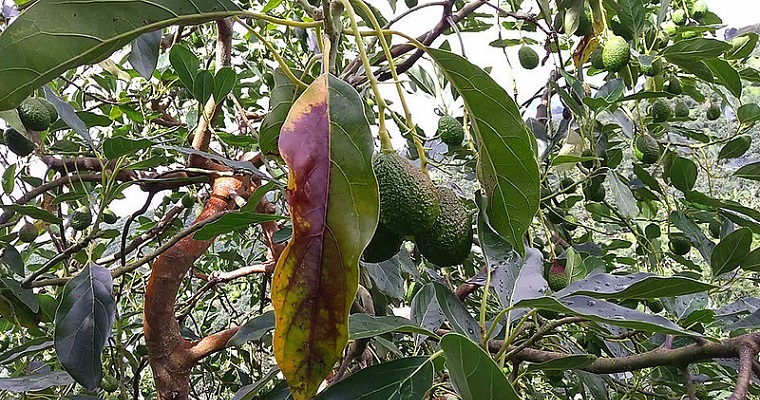
Anthracnose
Colletotrichum Gloeosporioides
Pathogène :
Fungus
Type:
Risque:
HIGH
Antracnosis




Descrição da doença
Colletotrichum gloeosporioides is a pathogenic fungus that affects various plants, including avocado. This fungus produces conidial spores in structures called acervuli, which emerge from infected tissues. Spores are dispersed mainly by splashing water and wind, finding new wounds or vulnerable tissues in which to germinate. Under favorable conditions of high humidity and warm temperatures, spores germinate and form appressoria that penetrate plant tissues. Once inside, the fungus colonizes the cells, causing necrosis and tissue death. As the infection progresses, more acervuli develop in the dead tissues, repeating the cycle. This process can be rapid, being completed in a few days under ideal conditions, which facilitates the spread and establishment of the pathogen in new areas.
Descrição do patógeno
In avocado, anthracnose caused by Colletotrichum gloeosporioides manifests itself with visible symptoms on fruits, leaves and branches. The disease begins as small black Taches that quickly expand, developing sunken, discolored areas. Severe infections can cause premature fruit and leaf drop, significantly affecting the productivity and quality of avocados.
- Black Taches on the fruits
- Sunken and discolored areas on fruits and leaves
- Premature fall of fruits and leaves
- Necrosis in young branches
- Reduction in the quality and size of the fruits
- Loss of vigor in the affected tree
TEMPERATURA E UMIDADE
25-30°C
85-95%
CAMINHOS DE TRANSMISSÃO</span
Wind, Water, Contaminated tools, Direct contact between plants, Insect vectors, Infected plant material
CONTROL
Tratamento químico
• CIPRODINIL 37.5% + FLUDIOXONIL 25% [WG] P/P
• CUPRIC HYDROXIDE 13.6% (EXPR. IN CU) + COPPER OXYCHLORIDE 13.6% (EXPR. IN CU) [SC] P/V
• CUPRIC HYDROXIDE 25% (EXPR. IN CU) [WG] P/P
• CUPRIC HYDROXIDE 50% (EXPR. IN CU) [WP] P/P
• LAMINARIN 4.5% [SL] P/S
• COPPER OXYCHLORIDE 35% (exp. in Cu) [WG] P/P
• COPPER OXYCHLORIDE 35% (EXPR. IN CU) [WG] P/P
• COPPER OXYCHLORIDE 37.5% (EXPR. IN CU) [WG] P/P
• COPPER OXYCHLORIDE 38% (EXPR. IN CU) [SC] P/V
• COPPER OXYCHLORIDE 50% (EXPR. IN CU) [WP] P/P
• COPPER OXYCHLORIDE 52% (EXPR. IN CU) [SC] P/V
• CUPROCALCIC SULFATE 20% (EXPR. IN CU) [WG] P/P
• CUPROCALCIC SULFATE 20% (EXPR. IN CU) [WP] P/P
• CUPROCALCIC SULFATE 20% (EXPR. IN CU) [WG] P/P
Tratamento biológico
• CUPRIC HYDROXIDE 13.6% (EXPR. IN CU) + COPPER OXYCHLORIDE 13.6% (EXPR. IN CU) [SC] P/V
• CUPRIC HYDROXIDE 25% (EXPR. IN CU) [WG] P/P
• CUPRIC HYDROXIDE 50% (EXPR. IN CU) [WP] P/P
• LAMINARIN 4.5% [SL] P/S
• COPPER OXYCHLORIDE 35% (exp. in Cu) [WG] P/P
• COPPER OXYCHLORIDE 35% (EXPR. IN CU) [WG] P/P
• COPPER OXYCHLORIDE 37.5% (EXPR. IN CU) [WG] P/P
• COPPER OXYCHLORIDE 38% (EXPR. IN CU) [SC] P/V
• COPPER OXYCHLORIDE 50% (EXPR. IN CU) [WP] P/P
• COPPER OXYCHLORIDE 52% (EXPR. IN CU) [SC] P/V
• CUPROCALCIC SULFATE 20% (EXPR. IN CU) [WG] P/P
• CUPROCALCIC SULFATE 20% (EXPR. IN CU) [WP] P/P
• CUPROCALCIC SULFATE 20% (EXPR. IN CU) [WG] P/P
Traitements biologiques
• BACILLUS SUBTILIS (STRAIN QST 713) 1.34% [SC] P/V
Recomendações
- Carry out regular monitoring of crops to detect the presence of symptoms early.
- Prune and remove infected parts of the tree to reduce the source of inoculum.
- Improve ventilation in plantations to reduce relative humidity.
- Apply preventive and curative fungicides following the specific technical recommendations for Colletotrichum gloeosporioides.
- Implement a crop rotation program to minimize the accumulation of pathogens in the soil.
- Avoid sprinkler irrigation that favors the dispersal of spores; prefer drip irrigation.
- Use resistant avocado varieties when possible.
- Disinfect pruning and harvesting tools to prevent the transmission of the pathogen.
TRAITEMENTS
Remèdes maison
There are no home treatments
Alliés naturels
Traitements chimiques
There are no treatments for this disease. Treatments are directed at the insect vectors that transmit it. See insect treatments.
RECOMMANDATIONS
- Check the back of the leaves frequently, especially in dry weather.
- Spray water on the leaves to increase humidity and prevent them from settling.
- Keep plants healthy with good watering and adequate light.
- If you see cobwebs or damage, clean the leaves with a damp cloth or pressurized water.
- Use potassium soap or neem oil every few days until they disappear.
Plantes répulsives
Rosemary, Dill, Coriander
PRODUITS RECOMMANDÉS
*Os tratamentos recomendados ainda são recomendações de acordo com os bancos de dados de autoridades e em nenhum momento substituem as diretrizes estabelecidas de acordo com a legislação de cada país
*Les produits présentés sont des recommandations et ne sont pas nos propres produits. En tant qu'associés Amazon, nous gagnons des revenus grâce aux achats de produits recommandés.





















